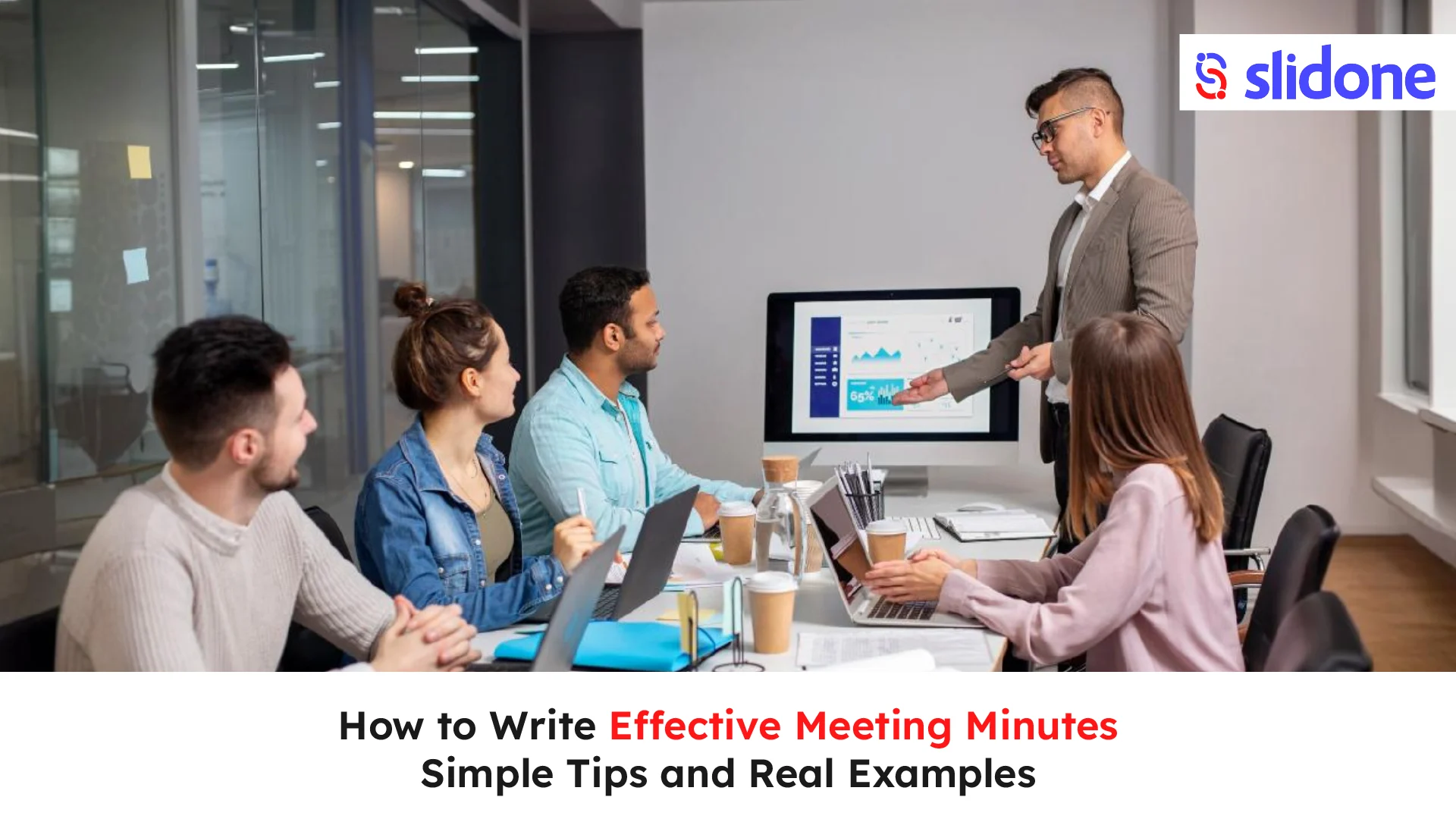Every professional setting finds meeting minutes a helpful tool in summarizing discussions that concern decisions and action items. The formulation of effective meeting of minutes should first present attendees and the date, along with key points discussed. Emphasize the decisions made, tasks assigned, deadlines, and responsible parties. Use simple, clear language so that any person who may read the document is sure of the next steps. In this blog, you will find simple ways of writing down minutes of the meeting with practical tips and real-life examples so your minutes can be more actionable, organized, and easy to follow for any team or project.
What Are Meeting Minutes?
These basically refer to the notes taken in the course of a meeting, which then give an overview of the key points taken up, decisions made, and responsibilities allotted. They stand as some sort of official recording of the meeting, as they help participants remember what transpired and whose responsibility it was to do what.
Key Components of Meeting Minutes
- Date and time of the meeting.
- List of those present and absent.
- Items discussed during the agenda proper.
- Decisions reached.
- Action items accomplished, naming the person in charge and deadline.
- Time and date of the next meeting, if any.
Minutes are normally taken during the meeting by an appointed note-taker or secretary and sent to all who attended the meeting.
Why Are Minutes of Meeting Important?
Minutes of the meeting are not merely simple notes but an essential element in business writing. Here are a few reasons why minutes of meeting matter:
- Track Progress: They offer a historical record of what was decided and assigned during that meeting. This helps participants remember what they are supposed to do and the teams track ongoing projects.
- Ensure Accountability: In meeting of minutes, action items are assigned to particular individuals, which in return makes sure that the tasks will be followed up and completed.
- Legal Documentations: These minutes can also be used as legal documents for a formal meeting where boards or committees make decisions.
They also improve team communication because they make all members aware of what is happening, even those who haven’t been able to attend the meeting; hence, complete transparency of the results is attained.
How to Prepare for Writing Meeting of Minutes

1. Understand the Meeting Agenda
Before every meeting, take some time to study the agenda. This will give you an overview of the important things to be covered so that you can be confident regarding what really matters during the meeting. It becomes easier to follow each leading point in the discussion if you know the agenda beforehand. Moreover, it makes note-taking easier because you will be more prepared in writing down essential points. Understand the meeting’s flow, so that you may not miss an important discussion that you may want to contribute to later on. Always be prepared by getting yourself introduced with the agenda.
2. Use a Meeting of Minutes Template
These save time and ensure that nothing is missed. A basic template for writing minutes includes the following information in its makeup:
- Title of Meeting:
- Date & Time:
- Location:
- Attendees:
- Subjects Discussed:
- Decisions Made:
- Actions to Follow:
- Next Meeting Date:
This structure ensures that everything regarding something important that was discussed or decided upon gets noted down coherently and continuously. It keeps everybody on the same page and ensures follow-up actions are not missed out on anything. This minimum structure works best for any regular session where every event needs to be recorded for future reference.
3. Assign a Note-Taker
Assigning a dedicated note-taker for a session is crucial to ensure all important points are captured. This person should focus on listening attentively, without the need to write down every single word. Instead, they should prioritize summarizing the main points, key decisions, and any actions that need to be taken. It’s important that the note-taker stays engaged throughout the session to avoid missing any vital information. Clear, concise notes can help team members refer back to decisions and next steps, keeping everyone aligned and informed after the session concludes.
Writing Effective Minutes of Meeting
1. Start with the Basics
When starting your conference of minutes, include the following information: the date, time, and location of the conference to provide clear context. Then, list all attendees present to ensure accountability and reference. If any participants are missing, make a note of their absence for future record-keeping. This introduction not only helps in organizing the minutes but also ensures that everyone involved is acknowledged and any absences are noted for transparency. Accurate documentation of these details sets the tone for well-organized and comprehensive conference records, ensuring clarity for all participants.
2. Focus on Key Points
While it’s important to capture the flow of the conference, focus on the major points such as:
- Decisions: What was agreed upon during the meeting?
- Action items: Who is responsible for specific tasks, and what are the deadlines?
- Discussions: Summarize important discussions without going into unnecessary detail.
Avoid including irrelevant or side conversations unless they directly impact the outcomes of the conference.
3. Be Clear and Concise
Write the minutes of proceedings in simple, clear language. Try to avoid technical jargon unless it is absolutely necessary for the context of the conference. Sentences should be short and succinct; this makes the minutes an easy read and simple to understand.
Example:
- Decision: The product launch will be delayed by two weeks.
- Action Item: Sarah to update the marketing plan by September 20.
Real-World Example of Effective Meeting Minutes
Here’s an example of well-organized and clear meeting of minutes:
Conference Title: Monthly Marketing Strategy
Date: October 1, 2024
Attendees: John, Emily, Sarah
Agenda Item 1: Social Media Campaign
- Key Decision: Increase social media ad budget by 20%.
- Action Item: John to update the budget report by October 5.
Agenda Item 2: Website Redesign
- Key Decision: Redesign homepage for better user experience.
- Action Item: Emily to deliver mock-up’s by October 10.
Agenda Item 3: New Product Launch
- Key Decision: Delay launch by one week to finalize testing.
- Action Item: Sarah to revise launch timeline by October 4.
Improving Meetings for All
Now that we’ve looked at how to take meeting minutes effectively, let’s turn our attention to the conference itself. How can you make your sessions more effective and productive?
Be it a workshop, a team conference, or a company-wide gathering, there are tools to ensure that all participants stay engaged from beginning to end. By using Slidone hybrid meeting tool, you will be guaranteed that your meetings are productive and that everyone stays involved.





Leave a Comment
Your email address will not be published. Required fields are marked *